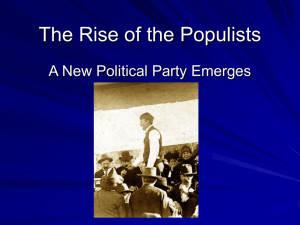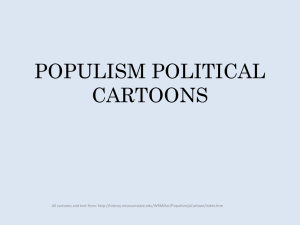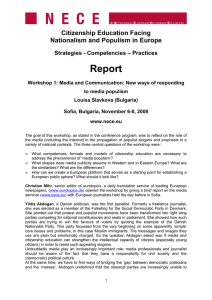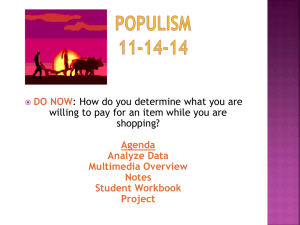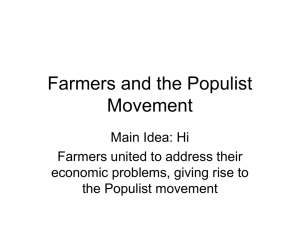CEPSI Parties and Populism CENTRE for
advertisement
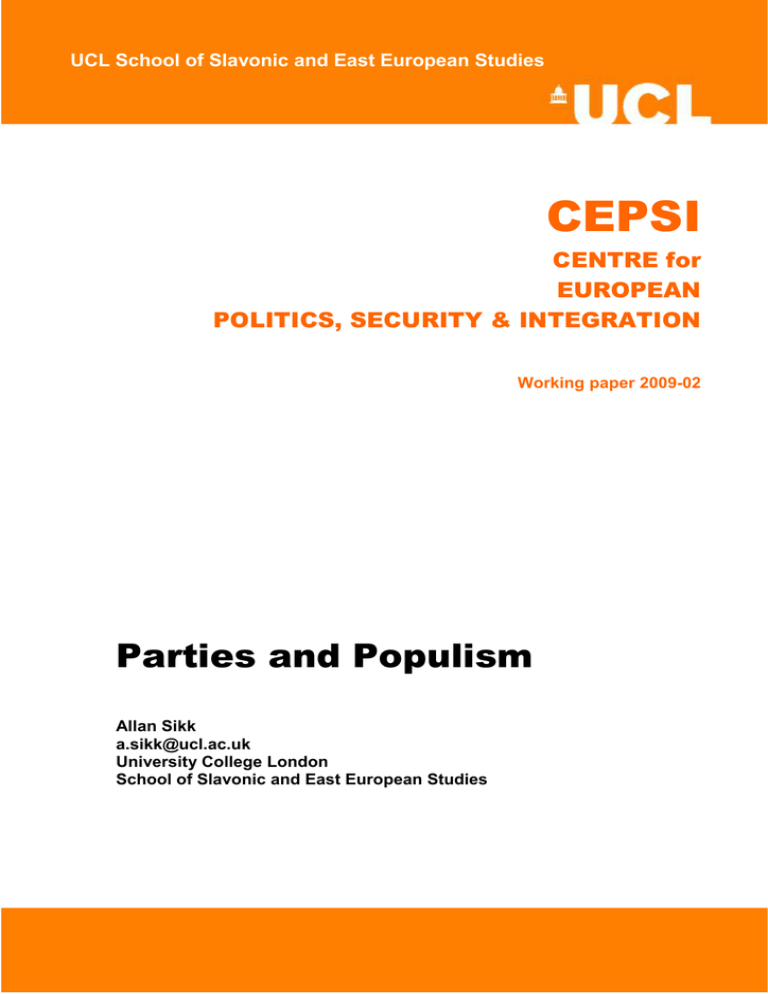
UCL School of Slavonic and East European Studies CEPSI CENTRE for EUROPEAN POLITICS, SECURITY & INTEGRATION Working paper 2009-02 Parties and Populism Allan Sikk a.sikk@ucl.ac.uk University College London School of Slavonic and East European Studies 1 ABSTRACT. Populism remains a fashionable concept in comparative politics even though its ambiguity and strong normative connotations are widely recognized. The term is also used with considerably different meanings in academic jargon and in the mass media. Many new political parties have been dubbed populist aided by the fuzziness of the definition and the absence of clear operational criteria. That has resulted in the grouping together parties of vastly different nature and varying degree of democratic credentials. Many new parties in Central and Eastern Europe have appeared in niches already occupied by old parties – the paper discusses three such cases in the Baltic states. The key factor to their success has been the project of newness that naturally incorporates a degree of anti-incumbency. The appropriateness of using a loaded term like populism can be questioned if the level of political corruption among the incumbents is objectively one of the most important problems in a country. Drawing a line between conscientious anti-corruption stance and opportunistic anti-establishment rhetoric poses problems. Equating a critical style with populism risks not only overstretching the already overstretched concept but may to a serious normative bias in favour of status quo – whatever it may mean in a given country. There is a widespread agreement in political science that the concept of “populism” remains useful despite a consensus about its elusiveness. This paper argues that the analytical value of the concept as it is used today is remarkably low; further problems are posed by its strong normative connotations and by the strikingly different meaning the term has amongst the general public and the med ia. While studies of populist ideology and rhetoric have provided some interesting insights into contemporary political competition, classifying or labelling political parties as “populist” remains controversial. The paper will start with a brief analysis of the ways in which the term has been used in party studies. Thereafter, we will discuss three highly successful Baltic parties that could be and have been classified as populist in literature. While certainly reflecting some properties of these parties, the term conjures up misleading composite images; in fact, these were “purifier” parties – with policy profiles similar to established parties but offering a cleansed ideology or cleaner approach to governing (Lucardie 2000, Sikk 2006) – that are susceptible to being classified as populist merely due to their newness coupled with weak ideological/programmatic underpinnings. The two reasons have very little to do with actual populist orientation and are simply related to the fact that one of the key issues of concern in these countries (especially in Latvia) was high-level political corruption – leading to strong anti-establishment stance of the new parties – and the predominance of catch-all electoral mobilisation in contemporary democracies, new 1 and old. The paper concludes with some suggestion for researchers who may still – for any reasons – wish to continue studying “populism” among political parties. On the Uses of “Populism” The term “populism” in party studies is used in three different ways: as a classifier, as a descriptor and as an admonition. None of them is without its problems, as discussed below. “Populism” as a classifier Here, the “populist parties” themselves are the focus of enquiry – e.g. we might be interested in the reasons behind the success of populist parties, their behaviour in parliaments or media, their secondary characteristics etc. In comparative terms, we are interested in which ways the populist parties are different from other, non-populist, parties. When “populism” is used as a classifier, a clear definition of the concept is of paramount importance, starting with clear definitional criteria (see Figure 1). Otherwise the set of parties under scrutiny might have omissions or, alternatively, might be contaminated by parties that should not be there in the first place. That may lead to incorrect conclusions about the populist parties. Note that misplacing parties in a populist or non-populist category is only half of the trouble here – the reference category becomes is also distorted due to omission or wrongful inclusion of cases. If the definition used is ambiguous, a grey zone of parties equally likely to be classified as populist or non-populist is created. Random decisions about the parties in the grey zone may have significant impact on our conclusions. Needless to say, all studies on populist parties would have to pay some attention to the referent category of nonpopulist parties – to make sure no populist parties are left behind and to have a benchmark against which to compare the populist parties. Mudde’s analysis of the European populist radical Right (Mudde 2007) and Jagers & Walgrave’s analysis of parties’ discourse in Belgium (Jagers & Walgrave 2007) are good examples to follow in regard to scrupulous separation of the wheat from the chaff. 2 Figure 1. Applying Concepts by Using Definitional Criteria It has been argued that many political science concepts are or should be based “family resemblance” rather than classical or Sartorian approach (Goertz 2005, Collier & Mahon 1993, cf Sartori 1970). Sartori’s approach to concepts has implicitly relied on the logic of necessary and sufficient criteria that allow us to distinguish between categories (Goertz 2005: 6). Essentially, we can make a positive classifying decision only if all necessary criteria are present. The family resemblance approach is based on the idea of logical disjunction1 and allows for more flexible definitions where the presence of all classifying criteria is not necessary (see Figure 2). Figure 2. “Classical” and “family resemblance” approach to concepts The family resemblance approach has significant potential in political science, but it also contains certain risks. First, while adding necessary criteria to a definition makes 1 In terms of formal logic, the classical approach connects criteria using the logical operand “AND” while family resemblance is based on “OR”. 3 concepts more specific and restrictive, adding “family resemblance” criteria may rather quickly leave us with too inclusive and general concepts (Mair 2008) – see Figure 3. Secondly, family resemblance approach is much more useful for a nuanced analysis of degrees of populism than blunt dichotomous categorisation of parties. The approach is related to a continuous scale of concepts where each extremity is inhabited by ideal types – respectively incorporating all and none of the criteria – that are virtually absent in the real world (Goertz 2005: 10, 84). Real instances only approach the extremes to different degrees and opting for a dichotomous categorisation is based on drawing (an arbitrary) dividing line somewhere on the scale. Thirdly, using a family resemblance approach is no excuse for vague and concealed operational criteria based on researcher’s whim. This logic is by no means better suitable for adopting a “loose set of features” (Howarth 2005: 2003) than is the classical approach. Figure 3. Family resemblance approach poorly applied Note: (a) applied too inclusively, (b) applied inclusively and loosely “Populism” as a descriptor The adjective of “populist” is sometimes used in party literature as a shortcut simply to describe certain parties. On one hand, this practice is less controversial than the poor use of “populism” as a classifier as it does not have the potential to lead to wrong theoretical conclusions. On the other hand, it is more problematic as often not even a loose definition is provided. Hence, images of the “tagged” parties are conjured up that may differ from a reader to reader. Often it remains a wild guess what the author 4 actually means by “populism” – i.e. what elements of the essentially contested concept or “loose set of family resemblance features” are included? These problems are further complicated by the fact that sometimes the adjective is used in the popular sense of the word. It is well known that public and academic meaning of “populism” are rather different (Mudde 2004: 542-32). These are bound to contaminate each other – researchers not working directly on populism may use the term in the popular rather than the academic sense. Most political scientists would probably welcome policy makers and journalists taking an interest in their writings. Sadly, very few of them would understand the literature on “populist” parties correctly; most would grossly misunderstand it; many would innocently believe “populism” is a kind of caveat – as is the commonplace in mass media. “Populism” as an admonition Certainly, most of the specialist literature on populism does not approach the issue from a (strongly) normative perspective. Yet, this is not true of everything. One of the most cited books containing the term in its title is William Riker’s attack on populism (Riker 1988). It should be noted that his definition of the concept is somewhat different from contemporary mainstream in party studies – he defines populism as the righteous belief in the will of the majority. Some other titles – regardless of their actual content – would sound normative, at least for the uninitiated: - “From Democracy Fatigue to Populist Backlash” (Rupnik 2007), - “Skinhead Conservatism: A Failed Populist Project” (Reyes 2008), - “Populism versus Democracy” (Abts & Rummens 2007), - “Twenty-first century populism: the spectre of Western European democracy” (Albertazzi & McDonnell 2008) - “Democracies and the Populist Challenge” (Mény & Surel 2002), At other times, populism has been discussed in explicitly and strongly negative terms (e.g. Bugaric 2008). There are, on the other hand, only rare cases when the concept 2 Mudde sounds rather dispassionate about the mismatch. We really ought to be worried about the public, the media and the politicians speaking a different language than the academics. 5 has been considered in both positive and negative normative terms – witness Philippe Schmitter’s discussion on “virtuous populism” (Schmitter 2007). Still, the term is highly charged in everyday public discourse and that remains the main concern. Certainly, much of political science is engaged in concepts that are “negative” throughout – both in public discourse and academic jargon – such as war, genocide, corruption, political oppression etc. Arguably, it is exactly the negative connotation that makes the study of these topics worthwhile. In a way, the same applies for the studies of “populism” – research into something that may endanger democracy is easy to sell to research councils and the general public. And it is just as well. In actual research phase we usually take a much more detached stance on the issues. Again, it is just as well. However, whereas the wars we study remain gruesome events, “populism” has for the most part been transformed into something so vague and heterogeneous that if the theoretical concept miraculously materialised one day, even those highly alarmed by it now would have hard time in making much sense of it. The following metaphor highlights the risks related to the issue. We teach children to beware of things that may burn themselves with but we do not expect them to transform the concept into something too abstract like “hot” – including the sun, nice bath, thoroughly cooked meal etc. If they were to think at such level of generalisation, they might either lose ability to distinguish between dangerous and safe or, what is even worse, develop a fear and distrust of anything mildly warm. The development of the concept of “populism” has in some ways been more worrying, as the meaning of the term has transformed in diametrically different directions in the public and academic discourse. In party studies, the concept has become highly inclusive and many instances mildly resembling “traditional” populism have become incorporated (including “benign populism”, see Učen 2007). In the public discourse, “populism” tends to incorporate anything popular that the user of the term detests.3 3 As Kevin Deegan-Krause (2007) puts it: “[in popular use] ‘populism is quite often simply the dark side of popularity, a mystery ingredient that explains why a rival political leader has inexplicably large support” 6 The Three Purifier Parties Around the turn of the century three highly successful new political parties appeared in three Baltic countries. In 2000, New Union (Social Liberals) won the support of 19.6 percent of voters becoming the second most popular party in Lithuania in its first elections. The winner of 2002 parliamentary elections in Latvia was the newly established New Era with 24.0 percent popular support. 2003 parliamentary elections in Estonia saw the rise of Res Publica that garnered 24.6 percent of votes, becoming one of the two strongest parties in parliament. A common thread among these parties was that they all attacked the corrupt practices of political establishment or government incumbents. In fact, anti-incumbency was a defining feature of these parties, as otherwise they were politically very similar to some major pre-existing parties. The project of “newness” as opposed to “old politics” was highlighted both at the substantive and rhetorical level. The parties campaigned for more open and accountable policies. The word “new” featured prominently either in their names, or in case of Res Publica in one of its main election slogans “New politics”. Even though the success of these parties was extraordinary, references to novelty in party names or slogans are not unusual. A “New Party” had appeared earlier in Latvia, whereas the British Labour party adopted a brand-name of “New Labour” in mid-1990s. Even more recently in Denmark, New Alliance was established and made it to the national parliament in 2007. The rhetoric of a fresh start or throwing the old rascals out has a populist echo to it, and based on several definitions of populism, the three Baltic parties could be classified as such (see Lang 2005, Učen 2007, Keris & Salla 2006, Pabriks & Štokenberga 2006). The parties made occasional appeals to more direct forms of democracy – especially the Lithuanian New Union that was established after an attempt gather signatures to initiate legislation. In contrast to many standard definitions of populism (e.g. Canovan 1999), the parties failed to make prominent references to the “common people”. However, if one considers anti-elitism or antiestablishment stance to be a central feature of the concept of populism, one can easily count the three as examples of populist parties. As new political contenders they had to contrast themselves to all old parties who had enjoyed being in office previously 7 and therefore the anti-incumbency stance often became hardly distinguishable from anti-establishment stance. Furthermore, what if corruption or unreservedly irresponsible policies are the most significant and real issues in a country? Should we use a derogatory term like “populism” for parties that try to tackle the issue, even if that means radical changes throughout the system of government, extending beyond the replacement of incumbent government with a new one? Indeed, throughout post-communist Europe, corruption is a serious issue and calls by (new) parties to tackle it only reflect the urgency of reports by Transparency International and the like. A thorough clean sweep might be exactly what is needed in order to avoid the countries falling ever deeper into the trap of corrupt practices. The events in Latvia between 2006 and 2009 – the arrest of Aivars Lembergs (see below), the fall of two governments, mass protests in Riga – highlight the issue, even though major corruption scandals have also shaken Lithuania and to a lesser extent, Estonia. Latvia has for some time been characterised by several parties confirming to a model of “pocket parties” that is little known outside the country. In essence, there is a widespread belief (with evidence it is not ungrounded) in Latvia that some – or even most – of the major parties are effectively “owned” by few very wealthy businessmen. In some cases the relationship has been more obvious than others, but during the last few years the backstage players directing Latvian party politics have become much more visible. For example, Aivars Lembergs – a tycoon and the long term mayor of an important port-town Ventspils – who has long been associated with some political parties, but is now under house arrest with corruption charges, stepped out of the sidelines before 2006 parliamentary elections. The legally contested removal by the government of the head of Corruption Prevention and Combating Bureau (KNAB) for trivial shortcomings in accountancy, eventually led to stepping down of the prime minister. Major questions were asked about the persistent influence of Andris Škele, prime-minister-turned-tycoon, on the leadership of the party he once headed. Even if “populist parties” as a concept is useful, we are faced with an everlasting question of where exactly should a line be drawn between conscientious anticorruption stance and opportunistic anti-establishment rhetoric. What level of 8 corruption – whether real or perceived – is “acceptable” so that anti-corruption rhetoric can be deemed as populist anti-establishment rhetoric? While classifying the three parties as populist is questionable, their own integrity and genuine intent to fight corruption should not be taken for granted. Even when corruption is a major issue close to the hearts of voters, the project of “newness” is a very opportune one for political entrepreneurs. That presumes, of course, accepting the possibility that not all new political parties are strictly a result of social pressures, but may rather be creations of political entrepreneurs willing to attain power, who monitor the society for any issues or divides they could exploit for their purposes. Newness as a project has several advantageous properties. The project promotes the cause of change, but not in any particular direction, thus having the potential to appeal to broad groups of the more and less disaffected or disappointed. As “newness” can be rather short of specific policy contents, the information costs associated with communicating the project to the voters are lower than with “ideological” or “issue” projects. When combined with being ideologically or programmatically in the mainstream – as the three “purifier” parties clearly were – newness does not risk of scaring off potential supporters who might be afraid of the political extremes and too drastic changes in policy directions. It was especially relevant given the time context of emergence of the new Baltic parties – the public had just learned to survive or manage with the recently settled market economy. Thus, even the less well off had learned strategies of survival and might well been afraid of too radical political changes. Besides subjective appeal of policy proposals, judgement of success potential might have played a role – parties in the mainstream can usually be expected to fare better than those at the fringes and thus a vote for them may appear more rational. Clearly, the project of newness with rather little new in terms of policy should ceteris paribus have little potential for mobilizing voters. For such a party to be successful, a strong combination of resources beyond an attractive project is needed. In case of New Era and New Union mobilization was aided by the charisma of party leaders. For Res Publica, it was based on a combination of considerable financial resources 9 and perceived competence and likeability of non-dominant party leaders. In all cases, the willingness of sponsors to support the party signalled to the electorates feasibility and moderate nature of the parties. Lack of clear ideologies should be seen as the fundamental disadvantage of “novelty” parties, as at the end of the day politics is about delivering public policies. Why should voters go for vague options? We may seem to underestimate the sophistication of the Baltic electorates here. For one, the sophistication might be less than perfect in a sense that voters pay less attention to programmatic profiles of political parties and rather focus on leaders and candidates. On the other hand, the real of perceived feasible national policy space can be argued to be relatively narrow because of constraints posed by globalization and Europeanization. Therefore, it may be entirely rational for voters to make their choices based on personal appeal or technocratic ability of party leaders. For the most part, until early 2000s, the incumbent parties had followed their electoral pledges and had managed to generate considerable economic growth. Thus, there was little reason to reject them on programmatic grounds. At the same time, their achievements had been tainted by a public perception of intolerably high level of corruption and social costs – unemployment, poverty and inequality. Therefore, promising a new style of politics without changing the content too much can be argued to have been in line with even the programmatic expectations of the Baltic electorates. What some authors would call “centrist populism” (Učen 2007) may thus be a rational winning strategy – elements of which are seen in all modern democracies dominated by ideologically flexible catch-all parties. However, it is questionable whether the application of the pejorative term is justified or whether the parties should be seen as any challenge to democracy. Disapproval of a respectable regime or government might be questionable, but condemnation of a disreputable one can be seen as a progressive force. Even if we manage to block out the derogatory everyday meaning of “populism” and use it as a value-free concept, is it useful for understanding the political world to analyse such parties somehow linked to “traditional” populist parties such as the (rather reasonable category of) “populist radical right” (Mudde 2007)? Or would it only create a super-category of political parties in which variance between individual units is almost as great as in the full universe of political parties? On the 10 other hand, all new parties take issue with incumbents – virtually by definition, as otherwise they should not appear in the first place. Equating their critical style with populism risks not only overstretching the already overstretched concept further, but may also lead us to a serious bias in favour of status quo – whatever form it takes in any given country. Discussion Imagine the following discussion on a concept: The flying creatures have a striking a variety of forms. They spend much of their time in the air and most of them have wings and eyes. Larger flying creatures have warm blood but many smaller ones are cold-blooded. There are certain types of flying creatures that do not possess all of the above characteristics but still spend significant amounts of time in the air – such as airplanes and falling leaves. As we have adopted only a vague “family resemblance” approach to concepts, airplanes and leaves can clearly be classified instances of flying creatures. Obviously, “flying creature” does not constitute a meaningful concept as it includes different things that only share a characteristic of flying. Even that is a purely functional similarity and has rather little to do with their very different nature. However, the rather pointless discussion does echo what we often see when “populist” parties are being examined: ‘ “[P]opulism” is most probably a “family resemblance” concept, so it will be a futile exercise to look for a very strict definition of the phenomenon’ … ‘[W]hat is striking about the present use of the term ‘populism’ is the almost unimaginable diversity of policies and actors it tries to cover. Yet commentators and political theorists who insist on using “populism” as a common family name for such diverse political players have a point. Only a vague and ill-defined concept like “populism” can allow us to grasp and reflect on the radical transformation of politics that is under way in many places in the world.’ (Smilov & Krastev, 2008: 7) If populism takes so many different forms, more specific terms like “plebiscitarian”, “radical”, “xenophobic”, “fiscally irresponsible”, “protectionist”, “illiberal”, “far right” etc would be much clearer and conceptually satisfying. Is the term “populism” 11 useful even in the admonitionary sense? To most of us, the adjectives listed above would convey a mild sense of contempt with much more substance. And if one just has a vague and general dislike for a particular party, why not call it “nasty”, “bad”, “feared”, “demagogic” etc rather than embellishing one’s text with academic jargon? As noted above, some uses of the concept are more promising than others. Academic research on a “thin” ideology of populism (see Stanley 2008) is certainly worthwhile as is the study into the use of populist style among political parties. The usefulness of the term as a classifier is doubtful. However, if researchers believe there are still good reasons for doing that, strict guidelines should be followed. Relying on family resemblance approach to concepts can be fruitful, but the specific operational criteria that follow broad definitional characteristics ought to be much clearer than they have been so far. Parties that one does not perceive as “populist” from the onset should never be overlooked in analysis. On a closer look, they might classify as such according to the criteria specified. If that turns out to be the case, the definition addresses something more general about the modern politics or contemporary electoral competition than “populism”. Definitions that label virtually all new parties as populist must be avoided – any such concept is a clumsy amalgam of “populism” and “newness”. Analysing degrees of populism in party rhetoric or programs is much more promising (as shown by Deegan-Krause & Haughton 2008) than the so far dominant dichotomous approach. To some extent, all parties are or appear to be populist. In a democracy it is but natural for opposition parties to make references to “the people” and bash incumbents – the less popular the incumbent, the more “people” and bashing. The worst operational criteria of all is researcher’s “awareness” that for a certain party it is “just rhetoric”, while “knowing” that another truly is populist and cunningly hides behind a veil of “mainstreamism”. Resorting to such strategy may indicate that the “populism” is not “out there” but is merely a mirage inside the researcher’s head. Bibliography Abts, Koen & Stefan Rummens (2007) “Populism versus Democracy”, Political Studies, 55(2): 405-424. 12 Albertazzi, Daniele & Duncan McDonnell, eds. (2007) Twenty-First Century Populism: The Spectre of Western European Democracy, Houndmills: Palgrave. Bugaric, Bojan (2008) “Populism, liberal democracy, and the rule of law in Central and Eastern Europe,” Communist and Post-Communist Studies, 41(2): 191203. Canovan, Margaret (1999). “Trust the people! Populism and the Two Faces of Democracy,” Political Studies 47(1): 2-16. Collier, David & James E. Mahon (1993) “Conceptual ‘Stretching’ Revisited: Adapting Categories in Comparative Politics”, American Political Science Review 87(4): 845-55. Deegan-Krause, Kevin (2007) “Populism and the Logic of Party Rotation in Postcommunist Europe”, in Oľga Gyárfášová & Grigorij Mesežnikov (eds) Visegrad Elections: Domestic Impact and European Consequences, Bratislava: Institute for Public Affairs (IVO). Deegan-Krause, Kevin & Tim Haughton (2008). “Live fast, die young? Populist appeals in Slovak politics in comparative perspective”, paper presented at the ECPR Joint Sessions, Rennes. Goertz, Gary (2005) Social science concepts: a user’s guide, Princeton, NJ: Princeton University Press. Howarth, David (2005) “Populism or Popular Democracy? The UDF, Workerism and the Struggle for Radical Democracy in South Africa” in Francisco Panizza (ed.) Populism and the mirror of democracy, London: Verso, pp. 202-223. Jagers, Jan & Stefaan Walgrave (2007) “Populism as political communication style: An empirical study of political parties' discourse in Belgium” European Journal of Political Research 46(3): 319-345. Keris, Maria & Jako Salla (2006) “The role patterns of minister’s personal advisors in politico-administrative dichotomy. Comparative case study of two Estonian ministries”, paper presented at the 14th Annual NISPAcee Conference “Public Administration and Public Policy in Emerging Europe & Eurasia: For Professionalism, Impartiality and Transparency”, Ljubljana, 11-13 May. Lang, Kai-Olaf (2005) “Populism in Central and Eastern Europe–A Threat to Democracy or Just Political Folklore?”, Slovak Foreign Policy Affairs, Spring: 6-16 Lucardie, Paul (2000) “Prophets, Purifiers and Prolocutors: Towards a Theory on the Emergence of New Parties”, Party Politics 6(2): 175-186. Mair, Peter (2008) “Concepts and concept formation” in Donatella Della Porta and Michael Keating (eds.) Approaches and Methodologies in the Social Sciences, Cambridge: Cambridge University Press, pp. 177-197. Mény, Yves & Yves Surel, eds. (2002) Democracies and the Populist Challenge, Houndmills: Palgrave. Mudde, Cas (2004) “The Populist Zeitgeist”, Government and Opposition, 39(4): 542563. Mudde, Cas (2007) Populist Radical Right Parties in Europe. Cambridge: Cambridge University Press. Pabriks, Artis & Aiga Stokenberga (2006) “Political parties and the party system in Latvia,” in Susanne Jungerstam-Mulders, ed. Post-Communist EU member states: parties and party politics. Aldershot: Ashgate. Reyes, Oscar (2005). “Skinhead Conservatism: A failed Populist Project”, in Francisco Panizza, ed. Populism and the Mirror of Democracy. London: Verso 13 Riker, William H. (1988) Liberalism against populism, San Fransisco: W.H. Freeman. Rupnik, Jacques (2007) “From Democracy Fatigue to Populist Backlash”, Journal of Democracy, 18(4): 17-25. Sartori, Giovanni (1970) “Concept Misformation in Comparative Politics”, The American Political Science Review 64(4): 1033-53. Schmitter, Philippe C. (2007) “A balance sheet of the vices and virtues of ‘populisms’”, Romanian Journal of Political Science, No. 2, pp. 5-11. Sikk, Allan (2006) Highways to Power: New Party Success in Three Young Democracies, Tartu: University of Tartu Press. Smilov, Daniel & Ivan Krastev (2008) “The Rise of Populism in Eastern Europe: Policy Paper”, in Grigori Mesežnikov et al, eds. Populist Politics and Liberal Democracy in Central and Eastern Europe, Bratislava: Institute for Public Affairs, pp. 7-12. Stanley, Ben (2008) “The thin ideology of populism”, Journal of Political Ideologies 13(1): 95 – 110. Učen, Peter (2007). “Parties, Populism, and Anti-Establishment Politics in East Central Europe,” SAIS review 27 (1): 49-62. 14 The Centre for European Politics, Security and Integration (CEPSI) at the School of Slavonic and East European Studies, University College London brings together academic staff, research fellows and research students in UCL and beyond with interests in the politics of contemporary Europe. Our goal is to be a catalyst for world class research and scholarship on the politics of contemporary Europe and to offer a space for the discussion of ongoing research and the development of new ideas anticipating contemporary policy debates. CEPSI Working series provides a a forum for the publication of high quality work-inprogress on all aspects of politics, security and integration in contemporary Europe and related theoretical perspectives. Relevant submissions of no more than 10,000 words and/or enquiries about possible submissions should be send to the Director of CEPSI Dr Seán Hanley; (e-mail: s.hanley@ssees.ucl.ac.uk) More information about CEPSI and its activities can be found on our website http://www.ssees.ucl.ac.uk/cepsi.htm 15

